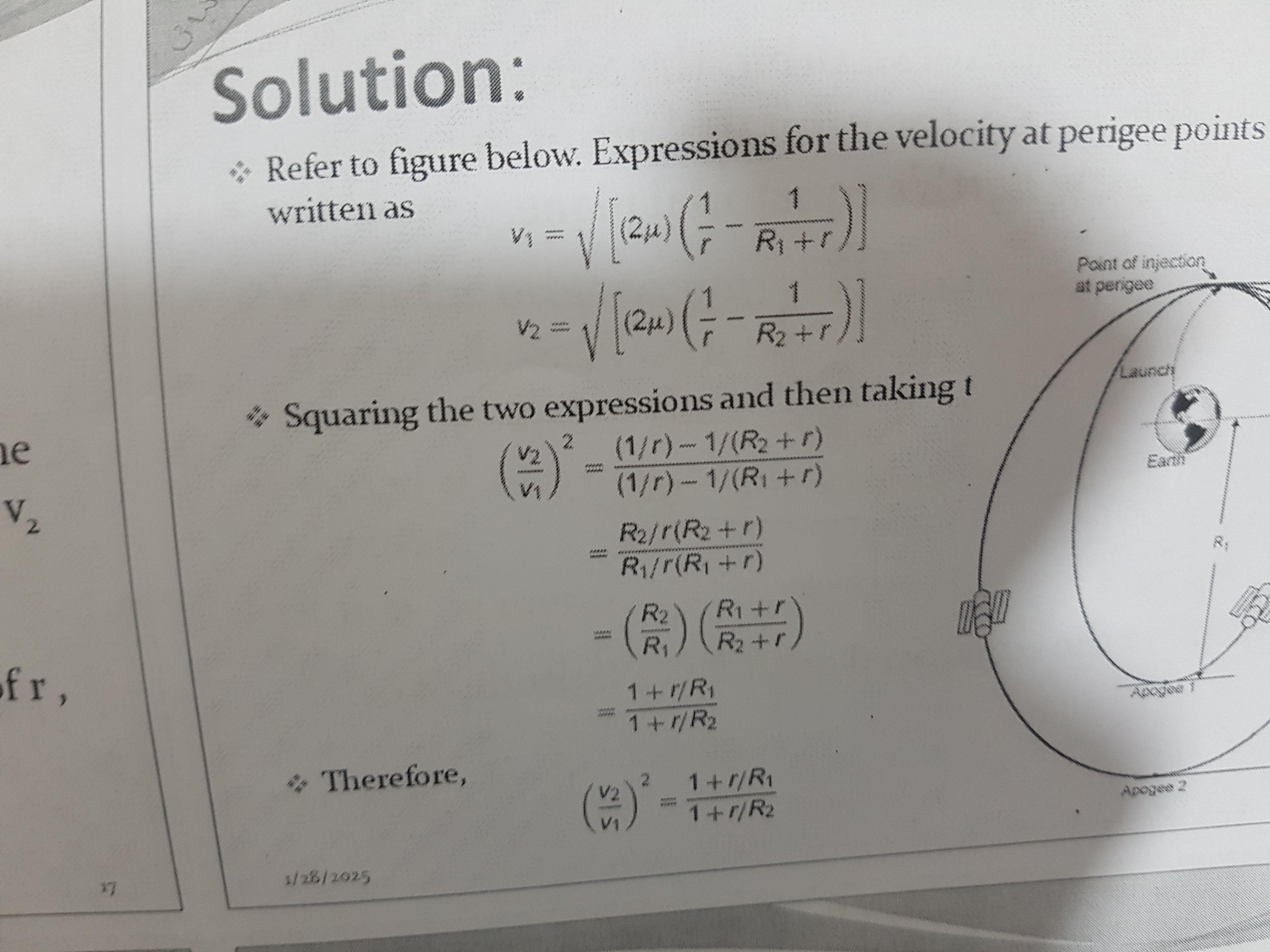Derive the expression for the velocity at perigee points as written in the image.

Understand the Problem
The question presents a derivation of a formula related to velocities at perigee points in an elliptical orbit, likely in the context of orbital mechanics or astrodynamics. It starts with expressions for velocities v1 and v2, squares their ratio, and simplifies the expression to a relationship involving the radii R1, R2, and r. You would likely need to use the provided information to either complete the question or answer other questions.
Answer
$(\frac{v_2}{v_1})^2 = \frac{R_2}{R_1} \cdot \frac{1 + r/R_1}{1 + r/R_2}$
Answer for screen readers
$(\frac{v_2}{v_1})^2 = \frac{R_2}{R_1} \cdot \frac{1 + r/R_1}{1 + r/R_2}$
Steps to Solve
- Square the expressions for $v_1$ and $v_2$
Squaring the given expressions for $v_1$ and $v_2$, we get:
$v_1^2 = (2\mu) (\frac{1}{r} - \frac{1}{R_1+r})$
$v_2^2 = (2\mu) (\frac{1}{r} - \frac{1}{R_2+r})$
- Find the ratio of $v_2^2$ to $v_1^2$
Divide $v_2^2$ by $v_1^2$:
$$(\frac{v_2}{v_1})^2 = \frac{(2\mu) (\frac{1}{r} - \frac{1}{R_2+r})}{(2\mu) (\frac{1}{r} - \frac{1}{R_1+r})}$$
Since $2\mu$ is a common factor, it cancels out:
$$(\frac{v_2}{v_1})^2 = \frac{\frac{1}{r} - \frac{1}{R_2+r}}{\frac{1}{r} - \frac{1}{R_1+r}}$$
- Simplify the fractions in the numerator and denominator
Simplify the numerator:
$\frac{1}{r} - \frac{1}{R_2+r} = \frac{(R_2+r) - r}{r(R_2+r)} = \frac{R_2}{r(R_2+r)}$
Simplify the denominator:
$\frac{1}{r} - \frac{1}{R_1+r} = \frac{(R_1+r) - r}{r(R_1+r)} = \frac{R_1}{r(R_1+r)}$
- Substitute the simplified fractions back into the ratio
$$(\frac{v_2}{v_1})^2 = \frac{\frac{R_2}{r(R_2+r)}}{\frac{R_1}{r(R_1+r)}}$$
- Simplify the complex fraction
$$(\frac{v_2}{v_1})^2 = \frac{R_2}{r(R_2+r)} \cdot \frac{r(R_1+r)}{R_1} = \frac{R_2(R_1+r)}{R_1(R_2+r)}$$
- Rearrange the terms
$$(\frac{v_2}{v_1})^2 = (\frac{R_2}{R_1}) (\frac{R_1+r}{R_2+r})$$
- Divide numerator and denominator by $R_1$ and $R_2$ respectively
$$(\frac{v_2}{v_1})^2 = \frac{\frac{R_2}{R_1}(R_1+r)}{\frac{R_1}{R_2}(R_2+r)} = \frac{R_2(1 + r/R_1)}{R_1(1+r/R_2)}$$
- Simplify further
$(\frac{v_2}{v_1})^2 = \frac{R_2}{R_1} * \frac{R_1(1 + r/R_1)}{R_2(1+r/R_2)} = \frac{1 + r/R_1}{1 + r/R_2}$ missing $R_2/R_1$ term
$(\frac{v_2}{v_1})^2 = \frac{R_2}{R_1} \cdot \frac{1 + r/R_1}{1 + r/R_2}$
More Information
The value of $\mu$ is the standard gravitational parameter, which is the product of the gravitational constant $G$ and the mass $M$ of the central body (e.g., Earth). The variables $R_1$ and $R_2$ represent the apoapsis distances of two different elliptical orbits, while $r$ represents the periapsis distance, which is the distance of closest approach to the central body. This formula relates the ratio of velocities at periapsis to the geometry of the orbits.
Tips
A common mistake is not simplifying the fractions correctly when finding the ratio of the squared velocities. Also, missing the R2/R1 term is another potential mistake.
AI-generated content may contain errors. Please verify critical information